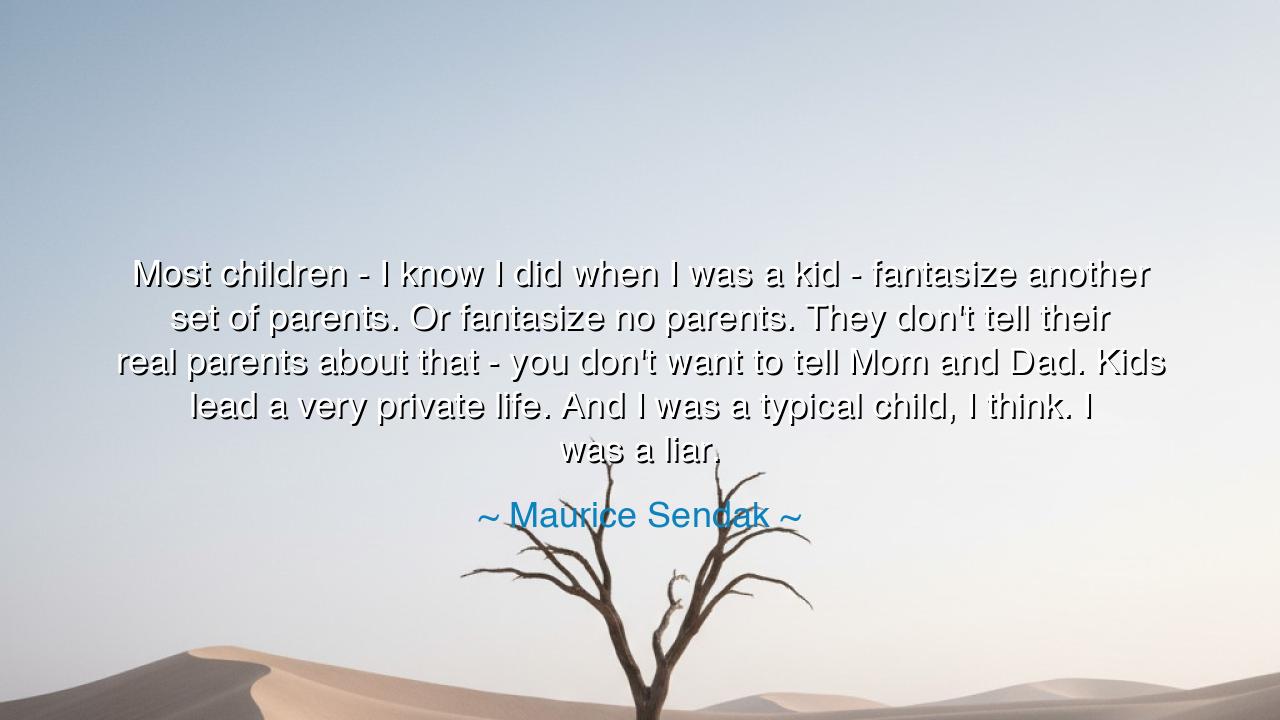
Most children - I know I did when I was a kid - fantasize another
Most children - I know I did when I was a kid - fantasize another set of parents. Or fantasize no parents. They don't tell their real parents about that - you don't want to tell Mom and Dad. Kids lead a very private life. And I was a typical child, I think. I was a liar.






In the words of Maurice Sendak, “Most children — I know I did when I was a kid — fantasize another set of parents. Or fantasize no parents. They don’t tell their real parents about that — you don’t want to tell Mom and Dad. Kids lead a very private life. And I was a typical child, I think. I was a liar.” These words, simple yet profound, open a window into the secret world of childhood imagination, where truth and fantasy intertwine, where innocence conceals both wonder and rebellion. Sendak, the great author and illustrator of Where the Wild Things Are, understood better than most that the heart of a child is not always pure in the way adults think, but honest in its longing, fierce in its emotion, and full of contradictions that shape the soul.
The origin of this quote lies in Sendak’s own childhood — one marked by isolation, frailty, and imagination. Growing up in a Jewish immigrant family during the Great Depression, he often retreated into his mind, building worlds of monsters, dreams, and wild freedom. His parents loved him, but they could not always understand him, and in that gap of understanding was born his private world — the secret universe that all children create when reality feels too small or too heavy. His confession, “I was a liar,” is not one of deceit, but of invention. He means that as a child, he invented stories, fantasies, even falsehoods, not out of malice, but out of the deep need to make sense of a world that often frightened or constrained him.
When he says that children “fantasize another set of parents,” he speaks to one of the oldest truths of childhood: the longing for freedom from authority, from rules, from misunderstanding. This is not hatred, but yearning — the yearning to be seen, to be understood, to feel powerful in a world where adults seem to control everything. In their private imaginations, children build other families, other selves — kings, heroes, or wanderers — all reflections of the freedom their young spirits crave. And though parents may never know these secret worlds, they are vital to the child’s growth, for in those dreams, the child learns who he is when no one is watching.
Sendak’s “private life” of childhood mirrors the stories of countless dreamers. Consider Hans Christian Andersen, who, like Sendak, grew up poor and lonely. He too invented worlds of talking mermaids, steadfast tin soldiers, and enchanted forests — all born from the same longing to escape and to belong. In his stories, as in Sendak’s, we see not rebellion for its own sake, but the creative power of solitude. The “lies” of childhood — the fantasies, the secret games, the invisible friends — are the first steps toward art, for in them the young soul learns to shape meaning out of emptiness. The child’s imagination, misunderstood by adults, is in truth a sacred flame — a rehearsal for the creation of worlds.
Yet, Sendak’s words also carry a shadow. When he calls himself “a liar,” he reveals not only the creativity of the child but also the fear — the instinct to hide one’s true feelings from those who might not understand. Children conceal their inner lives because they fear breaking the fragile peace of the household. They learn early that truth can wound, that honesty can bring punishment or disappointment. And so they craft stories — sometimes small lies, sometimes grand fantasies — to protect their hearts. What adults call deceit is often a child’s way of survival, of keeping a piece of themselves untouched by the world.
The lesson, then, is one of compassion and remembrance. We must never forget the private life of the child — for within every adult lives that same hidden dreamer, that same little liar who once made up stories to survive. Parents, teachers, and elders must learn to honor that privacy, to give children room to imagine without fear of scorn. The greatest gift we can give the young is not control, but understanding — the permission to dream, to be strange, to create and destroy their worlds in play, knowing they are loved regardless. For from that fertile soil of imagination grows the artist, the thinker, the visionary.
So, my children of the present age, when you meet the lies of youth — the wild stories, the imaginary friends, the impossible dreams — do not crush them with laughter or disbelief. Instead, listen. Ask what world the child is building, and what truth hides beneath the fantasy. For the heart that learns to imagine learns also to empathize, to see beyond what is visible. As Sendak reminds us, every child is a secret world, and to understand that is to understand creation itself. Let us then be gentle with those lies, for they are not deceit, but the first sparks of the divine imagination that moves within us all.
And remember this: though childhood passes, its wild truth remains. Within every adult still echoes the voice of that hidden child — the one who dreamed of other parents, other worlds, and other selves. To live fully is not to silence that voice, but to listen to it with love, and to carry its imagination forward into all we create. For in the end, the “liar” becomes the storyteller, and the fantasy becomes the light that guides the world.






AAdministratorAdministrator
Welcome, honored guests. Please leave a comment, we will respond soon